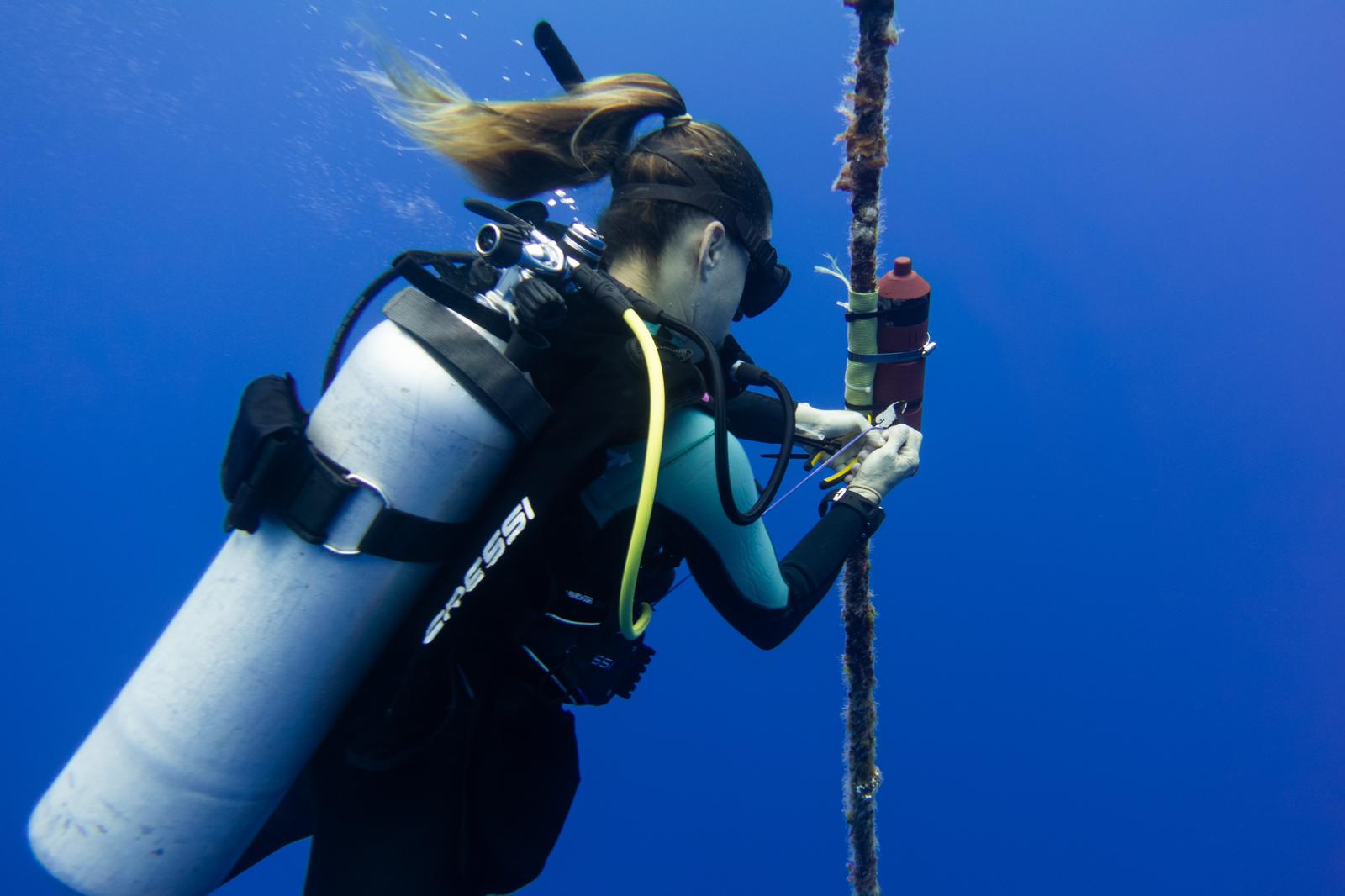If you’ve been following us for a while, then you know that we tag sharks. But you may not be clear on what types of tags we use and why. Here we will shed a little light on our tagging methods and their purposes.
We’re currently deploying three types of tags; one is primarily for identification and two are for tracking shark movements.
IDENTIFICATION (ID) TAGS

Shark dorsal fin with identification tag.
First, let’s talk about the ID tag. There are a few different types but, for this post, we’re going to focus on dorsal fin ID tags. These are actually livestock ear tags (sheep!) and the Texas-based company that we ordered them from had a chuckle when we said we’d be putting them onto sharks. (Fun side note: we sent them a photo so they could prove it to friends and family).
ID tags are one of the oldest ways of collecting movement information. The tags generally have a visible number as well as contact information and instructions for anyone who catches the animal. Before electronic tags existed for collecting shark movement data, scientists would rely on ID tags for “mark-recapture” studies. Sharks would be tagged off of a boat in one location (e.g. North Carolina) and then whichever boat caught the animals in another location (say, in Maine) would relay the information on where it was caught, the size, species, tag number and any other relevant info. The scientist would then be able to determine how far the shark traveled from the time it was tagged to the time it was caught. In other words, the scientists were relying on the kindness of strangers to report where they saw the tagged shark and any biological data such as size. This is still true today. Our ID tags have an email address and request for information if the animal is caught. We hope that if a fisherman catches or a diver sees the shark, they will let us know.
While cheap and easy to deploy, ID tags are limited by the fact that the tags themselves do not collect and store data. We can also use ID tags to measure the abundance of sharks on a reef by tagging every shark they caught in a reef area. While we get less detailed information from ID tags than other types, they also have fewer challenges.
SATELLITE TAGS
Satellite tags, also called “pop-off archival tags,” or “PAT tags” for short, help us learn about broad scale movement patterns. This is a useful tool for learning about pelagic sharks traversing vast distances in the open ocean. Satellite tags are capable of collecting and storing a variety of movement information, unlike ID tags.

A satellite tag is deployed on a Silky Shark.
Inserted in the shark’s back at the base of the dorsal fin, satellite tags float alongside the shark as it swims. While on the shark, the tag collects depth, temperature, and light-level data for geolocation. On a preprogrammed date (for example, 12 months later), the tag will detach from the shark and float to the surface. Once at the surface, the tag transmits its archived data to a satellite. We can then download that information to our computers and calculate the shark’s movement patterns both vertically and horizontally in the water column.
While they are much more costly than ID tags (we’re talking cents versus thousands of dollars), the data captured by satellite tags is invaluable. Unfortunately, there are times we don’t even get the data because the tag fails and detaches prematurely—this is incredibly infuriating, but part of the deal! And, occasionally, we’ll get limited data (less than our hopeful 12 months, for example) because the shark lost the tag in a skirmish or was killed, either by fishers, another marine predator, or some combination of factors.
When we do get the data (cue angels singing), even if we don’t get a full 12 months, it provides invaluable information on where the shark has gone, at which time of day, and over which seasons. This data helps us to identify any specific habitats (like whether there is a seamount they congregate around), movement patters or migrations, effectiveness of large marine protected areas or shark sanctuaries, and even overlap with fishing hotspots. This information is essential for shark conservation and sustainable management, because if we know where the shark is going and when, then we can better work with fisheries managers and fishers to protect any threatened species.
ACOUSTIC TAGS

Jess Cramp attaches an acoustic receiver to a FAD line.
Acoustic tags are the third type of tag we’re currently deploying to help us understand the movement patterns of sharks. These tags are used for fine-scale (i.e. reef-scale) movements, to determine residency, for example. This is opposed to the broad ‘ocean-scale’ movements tracked with satellite tags. They can also collect pressure data to examine depth patterns of sharks, as well as horizontal movement patterns.
Unlike satellite tags, which store movement data onboard the tag, acoustic tag data is actually stored in a receiver (or listening station), which receives the pings from the tagged shark as it swims by. Because of this, when we are using acoustic tags, we have to put out an array of receivers along a reef to capture the data. Acoustic receivers are anchored in place, for example on a fish aggregating device (FAD) or on the reef and can collect pings from acoustic tags up to 1km (.62 mi) away in clear water. The receiver array can be large, like the array that spans the Great Barrier Reef and captures acoustic data on sharks, fish, sea snakes, dugongs and other marine creatures; or it can be smaller and isolated on a single island in a remote location, like our array in Niue.
Acoustic tags and receivers are cheaper than satellite tags, but they are usually used to answer different scientific questions, so the two can’t be used interchangeably. However, they’re often used together to get both broad- and fine-scale movement data! You wouldn’t put both a satellite tag and an acoustic tag on a coral trout, for example, because these fish don’t swim far enough to make it worth using a satellite tag on—plus, the tag is too big for that little fish! But you would put both tags on a Silky Shark, since they might swim between countries or they might hang out in one island for a while. Once acoustic tags are deployed, the receivers begin collecting information immediately. In order to retrieve the acoustic tag data from a receiver, you must physically go and collect it. Then the data is downloaded to a computer and analyzed. Once analyzed, you can put the receiver back in the water to keep collecting data.

Teuru Passfield deploys an ID tag on an Oceanic Whitetip Shark, after first deploying a satellite tag.
Acoustic tags come with their own set of challenges, though. For example, sometimes really rough weather or cyclones can unexpectedly wash the receivers away. Or, a global pandemic strikes, placing travel restrictions that make it hard for us to get back to our sites to retrieve our receivers. Luckily, we are partnered with local researchers and fishers who are taking the plunge for us. Afterall, science is a collaborative process!
As you can see, tags are an integral part of our shark research methodologies and each comes with its own set of benefits and challenges. However, all of the data we collect is crucial to getting us closer to creating effective policies that can result in long-lasting protection for sharks.
Be sure to follow us on social media and keep an eye out for future posts about our data! We look forward to sharing what we’ve gathered from our tagging methods as it becomes available and we also look forward to getting back in the field and sharing stories about our research again soon!
Until next time!



